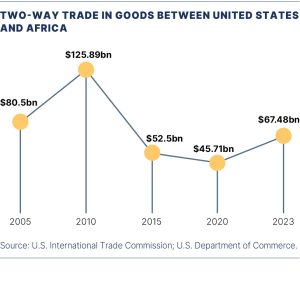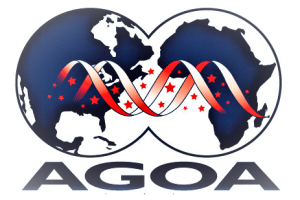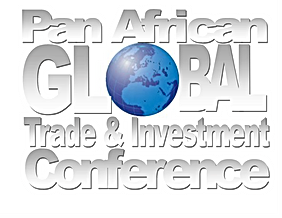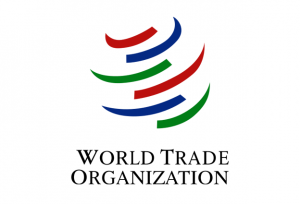Sub-Saharan Africa Trade Relations
Sub-Saharan Africa Expected to See Growth in 2025; Needs More U.S. Engagement
• Sub-Saharan Africa will have 25% of the world’s population by 2050.
• Sub-Saharan Africa is home to the world’s second largest rainforest and 30% of the world’s critical minerals.
• California exported $727 million to the region in 2023.
The World Trade Organization (WTO) reported in October 2024 that the sub-Saharan African region is expected to have a 3.3% increase in gross domestic product (GDP) growth for 2024, the third strongest export growth of the WTO regions. Sub-Saharan Africa resiliency continues as exports are expected to grow by 2.5% in 2024, with imports expected at only 1%, due to a predicted “larger-than-expected” drop in imports from one of its major trading partners, Europe. This is also despite many economic and social risks in the region.
According to the Economist, no other country comes near the depth and breadth of China’s engagement in Africa. It is Africa’s largest trading partner, bilateral creditor and a crucial source of infrastructure investment. Chinese firms account for an estimated one-eighth of the continent’s industrial output. Chinese-built digital infrastructure is critical to the platforms on which Africans communicate. Political, military and security ties are becoming closer.
African Growth and Opportunity Act
 The African Growth and Opportunity Act (AGOA) is a trade preference program that has been the model behind U.S.-African trade and investment since it was enacted in 2000. The AGOA provides duty-free entry into the United States for almost all African products. This has helped to expand and diversify African exports to the United States. In 2015, the U.S. Congress renewed AGOA; it will be up for renewal in 2025.
The African Growth and Opportunity Act (AGOA) is a trade preference program that has been the model behind U.S.-African trade and investment since it was enacted in 2000. The AGOA provides duty-free entry into the United States for almost all African products. This has helped to expand and diversify African exports to the United States. In 2015, the U.S. Congress renewed AGOA; it will be up for renewal in 2025.
In 2023, U.S. imports under AGOA totaled $9.3 billion. This consisted of approximately $4.2 billion in crude oil and $5 billion in other products, including $1.9 billion in motor vehicles and more than $1.1 billion in textile and apparel.
The AGOA embodies a trade and investment-centered approach to development. Enactment of the AGOA has stimulated the growth of the African private sector and provided incentives for further reform. The AGOA is aimed at transforming the relationship between the United States and sub-Saharan Africa away from aid dependence to enhanced commerce by providing commercial incentives to encourage bilateral trade. Since 2000, AGOA has helped increase U.S. two-way trade with sub-Saharan Africa.
African Continental Free Trade Area
The African Continental Free Trade Area (AfCFTA) was brokered by the African Union in 2018, with the pan-African free trade zone taking effect on January 1, 2021.
The AfCFTA will have far-reaching benefits for the region, representing the opportunity for countries in sub-Saharan Africa to boost long-term economic growth, reduce poverty and broaden economic inclusion. The AfCFTA creates the largest free trade area in the world by area and number of participating countries, connecting more than 1.4 billion people across 55 countries with a total GDP of $3.4 trillion. As of February 2024, 54 of the 55 African Union member states have signed the AfCFTA agreement and 47 have deposited their instrument of ratification.
Supporters hope that the agreement will lift 30 million people out of extreme poverty and boost income in Africa by $450 billion by 2035, a 7% gain. The World Bank also estimates that the AfCFTA could raise Africa’s exports to the world by 32% by 2035. Over the next 5 to 10 years, 90% of tariffs for goods traded within the bloc will be liberalized.
U.S.-Kenya Trade Agreement
In 2020, the first Trump administration notified Congress of the intent to enter into negotiations for a U.S.-Kenya trade agreement.
A trade agreement between the United States and Kenya would be the first between the United States and a sub-Saharan African country and would complement Africa’s regional integration efforts, which include the landmark AfCFTA.
From its location on the eastern coast of Africa, Kenya serves as a gateway to the region and opportunities for U.S. consumers, businesses, farmers, ranchers and workers.
In July 2022, the Biden administration launched the U.S.- Kenya Strategic Trade and Investment Partnership (STIP) to take the place of the U.S.-Kenya Free Trade Agreement that never materialized.
U.S.-Kenya bilateral trade currently exceeds $1.38 billion annually. In 2023, U.S. exports to Kenya totaled $485 million, while imports into the United States from Kenya totaled $894 million.
U.S.-Africa Policy Tools
• Power Africa aims to add more than 30,000 megawatts of cleaner, more efficient electricity generation capacity and 60 million new home/business connections through private public partnerships. As of September 2024, Power Africa has afforded nearly $26 billion for 154 power projects across the continent for 14,311 megawatts of new electricity that will power more than 43.1 million households and businesses.
• Millennium Challenge Corporation (MCC) provides large grants (in the hundreds of millions of dollars) to promote economic growth, reduce poverty and strengthen institutions.
• The U.S. International Development Finance Corporation (DFC) replaced the Overseas Private Investment Corp. in 2021 and has an expanded mandate and greater resources. The DFC marked its largest fiscal year in 2023 with $9.3 billion committed across 132 transactions to address the world’s greatest challenges.
• Prosper Africa is a one-stop shop to facilitate increased trade and investment between U.S. and African businesses.
Agenda 2063
Agenda 2063 is Africa’s blueprint and master plan for transforming itself into the global powerhouse of the future. AfCFTA is one of the flagship projects. Agenda 2063 has been described as “a concrete manifestation of the pan-African drive for unity, self-determination, freedom, progress and collective prosperity pursued under Pan-Africanism and African Renaissance.”
In affirming their commitment to Agenda 2063, African leaders called for reprioritizing Africa’s agenda from the struggle against apartheid and attaining political independence for the continent, to inclusive social and economic development, continental and regional integration, democratic governance, and peace and security, among other issues.
In February 2022, the African Union released the Second Continental Report on the Implementation of Agenda 2063, noting the continent performed strongly and has made progress since 2019. The Second Ten-Year Implementation Plan is set to cover 2024–2033.
Anticipated Action
It is crucial for the U.S. Congress to renew the African Growth and Opportunity Act to continue to invest and grow trading relationships in Africa. It is hoped that the second Trump administration will continue with negotiations for a U.S.-Kenya Strategic Trade and Investment Partnership, and that the African Continental Free Trade Area will continue to reap benefits for the region.
CalChamber Position
The California Chamber of Commerce believes that it is in the mutual economic interest of the United States and sub- Saharan Africa to promote stable and sustainable economic growth and development in sub-Saharan Africa and that this growth depends in large measure upon the development of a receptive environment for trade and investment.
The CalChamber is supportive of the United States seeking to facilitate market-led economic growth in, and thereby the social and economic development of, the countries of sub- Saharan Africa.
In particular, the CalChamber is supportive of the United States seeking to assist sub-Saharan African countries, and the private sector in those countries, to achieve economic self-reliance.
February 2025
Agriculture and Resources
California Environmental Quality Act (CEQA)
Climate Change
Education
Energy
Environmental Regulation
Health Care
Housing and Land Use
Immigration Reform
International Trade
Labor and Employment
Legal Reform
Managing Employees
Privacy
Product Regulation
Taxation/Budget
Tourism
Transportation
Unemployment Insurance/Insurance
Water
Workers’ Compensation
Workplace Safety
Recent News
International Bills
Councils
Coalitions
- Alliance for Fair Trade with India
- California Coalition for Free Trade
- Federation of International Trade Associations
- North American Rebound
- Trade Works for US
- U.S. Council for International Business (USCIB)
- USA * Engage
Policy Contact
 Susanne Stirling
Susanne Stirling
Senior Vice President, International Affairs





